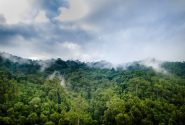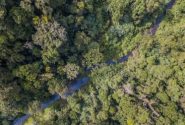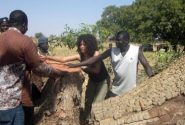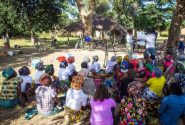JEJU, South Korea (10 September, 2012)_People crowd together under umbrellas at Ogbette market in the Nigerian city of Enugu in an attempt to hide from the heat, which can reach a sweltering 39 degrees Celsius. But follow the three-wheeled keke napep motorcycles out of the city centre, and you’ll find the natural environment a much more pleasant temperature of 29 degrees Celsius.
The obsession with replacing real jungles with those of the concrete persuasion has seen temperatures in cities rise formidably, creating what scientists term ‘urban heat islands’.
And the lack of greenery in city centres has important implications for the way urbanites are able to cope with the challenges of a warming world, said Emilia Pramova, a climate change adaptation scientist with the Center for International Forestry Research and co-author of a presentation delivered at the World Conservation Congress in Jeju, South Korea last week.
“Urban development often replaces vegetated surfaces — which provide shading, cooling, rainwater interception, storage and infiltration functions — with impervious built surfaces that are not capable of providing any of these services,” she said.
According to a UN report released in 2007, over half of the world’s population now live in cities such as Enugu. Africa is projected to more than double its population by 2050 to 1.9 billion, most of which is expected to occur in poverty-stricken sub-Saharan Africa. While still predominantly rural, much of the continent’s coming growth will be in urban areas, having significant implications for city planners and policymakers.
Studies of Enugu’s urban situation recommend a 50 percent increase in residential tree cover, however planting just ten percent more trees in town centres dominated by concrete such as in the UK city of Manchester has been found to decrease surface temperatures by over 2˚C and reduce excess water flow from heavy rains by up to six percent.
But, as Pramova points out, studies on urban ecosystems in general have mostly focused on developed countries.
Planting just ten percent more trees in town centres dominated by concrete … has been found to decrease surface temperatures by over 2˚C
“Research on forests in urban adaptation to climate variability in developing countries is still in its infancy,” she said.
“Urban centres in developing countries face more complex challenges as many of them lack adequate “grey” infrastructure (e.g. bridges, sewage systems) and have big proportions of their population living in slums and other high-risk areas that are disaster-prone and ill equipped for adaptation. They face multiple hazards and risks and multiple measures will be needed in addition to green strategies.”
Further hampering progress is the high cost of creating large new green spaces in many existing urban areas. Thus, policymakers would have to make the most of all opportunities, considering everything from roof gardens and street tree planting to converting selected streets into green corridors.
Urban greening initiatives could also be linked to mitigation policies such as reduced energy consumption for cooling and sectoral programmes that can provide partial funding.
However strategies to manage climatic changes in urban areas should also consider ‘ecological networking’ to utilise the important role of forests in other regions and also strengthen biological corridors.
“We are starting to see green systems developing. In Beijing, for example they are proposing an ecosystem based strategy where regions (natural forest maintenance), cities (parks and green corridors) and neighbourhoods (road greening) are all participating to enhance overall benefits,” Pramova said.
This work is part of the CGIAR Research Program on Forests, Trees and Agroforestry.
We want you to share Forests News content, which is licensed under Creative Commons Attribution-NonCommercial-ShareAlike 4.0 International (CC BY-NC-SA 4.0). This means you are free to redistribute our material for non-commercial purposes. All we ask is that you give Forests News appropriate credit and link to the original Forests News content, indicate if changes were made, and distribute your contributions under the same Creative Commons license. You must notify Forests News if you repost, reprint or reuse our materials by contacting forestsnews@cifor-icraf.org.













